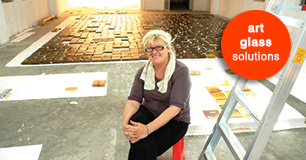
Artists are driven by motives that are not always obvious. They do things differently to the norm as it seems their creative ideas come out of nowhere. As an artist I identify with this notion as I have worked intuitive from the start. More recently I am able to focus and create a ‘state of mind’ that is conducive to the ‘spark of creativity’ to create a ‘new idea’.
Having a better understanding about how I think, how this differs from the thought processes of others, is important when working with larger project teams tasked to install large architectural installations. Carolyn Gregoire discusses in a recent article that creativity is more complex than the right/left brain distinction stating that the left brain is rational and analytical, and the right brain is creative and emotional. She explains that creativity involves a number of cognitive processes, neural pathways and emotions, and trying to pin down a creative personality type is difficult as creative people are complex, paradoxical and tend to avoid habit or routine. Further, the stereotype of the “tortured artist” is not necessarily accurate. Artists tend to be complex as their creativity comes together as a multitude of traits, behaviours and social influences.
Gregoire notes that while there is no “typical” creative type, there are 18 characteristics and behaviours that indicate the “Things Highly Creative People do Differently”. She says artists daydream, they observe everything, work the hours that suit them and take time for solitude to facilitate the creative process. They turn life’s obstacles into creative challenges and express their hardships as stories, iconic songs, paintings and sculptures to illustrate new life possibilities.
Creative people continue to seek out new experiences; they ask the big questions about life and maintain a keen sense of curiosity. They spend time people watching, take risks and view their experiences as an opportunity for self expression. They think differently, take different positions so as to view life from new perspectives and ‘connect the dots’ that may seemingly appear unconnected to others. They find solutions in abstractions that might otherwise seem unrelated.
During the creative process artists lose track of time, are mindful and create space to clear their mind so as to focus and think about things. This process allows them to tap into their most creative state of mind. Artists ensure to surround themselves with things of beauty, they search for new experiences and see situations in a different light. Most of all, against all odds, they follow their true passion.
Understanding and acknowledging how the creative mind works is important as artists can play a vital role within work teams, communities and society. Allowing artists to work and think in their own way, means new ideas and different work practices can be considered. Artists provide new perspectives, connect the dots and facilitate new understanding.
Although the new ideas might seem to come ‘out of nowhere’ by artists who don’t follow the normal rules, their creative thinking is beneficial as it initiates the development of new products and different techniques – which eventually leads to innovative solutions, creative approaches and ultimately business growth.
Without artists and their new ideas, there would be no future business opportunities.
Reference: “18 Things Highly Creative People Do Differently” by Carolyn Gregoire at Carolyn.Gregoire@huffingtonpost.com
By B. Jane Cowie, Artist and Educator








